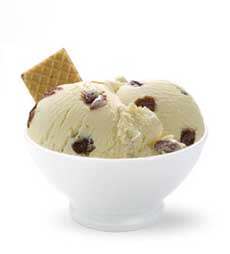TIP OF THE DAY: Make Easy Rum Raisin Ice Cream

|
Our favorite Thanksgiving ice cream flavor is not Pumpkin, but Rum Raisin. It’s an old-fashioned flavor that seems very American (as rum was produced close to home, in the Caribbean). Actually, its roots are in Sicily; the history is below. It’s easy to make Rum Raisin from basic Vanilla ice cream: Marinate the raisins overnight in rum and sugar. Drain and stir the raisins into softened vanilla ice cream. Return the ice cream to the freezer to harden. Even easier: Use the rum-soaked raisins as a topping on vanilla ice cream, or interspersed in a parfait. TIP: We usually have a jar of rum-soaked raisins in the fridge, and give jars of it as gifts. It’s better visually to mix purple and golden raisins (sultanas). For Christmas, we add some dried cranberries; and also make a separate concoction of dried cranberries in a mix of rum and cranberry liqueur. All versions are delicious in a cup of hot tea. If you want to make Rum Raisin Ice Cream from scratch, here’s a recipe from Saveur. It’s so much more special than vanilla ice cream, with: |
|
|
THE HISTORY OF RUM RAISIN In Sicily, where it originated, what we call Rum Raisin is known as Málaga. The Sicilians were the first to create Rum Raisin gelato, which was originally made with the local Marsala wine instead of rum. The raisins were soaked overnight in the wine and then mixed into vanilla gelato*. The sweet Málaga raisins with a burst of alcohol were a hit, and led to Rum Raisin/Málaga flavors in other desserts. Bread puddings, cakes (especially fruit cakes and pound cakes), cookies, custards, pastries, pies and puddings were all enhanced with rum-soaked raisins. A grass originally from the the Pacific islands of Melanesia and Polynesia, sugar cane was introduced to the Caribbean in 1493 by Christopher Columbus [sugar history and source]. By the 17th century, the Caribbean had become the major source of sugar for the West. Molasses is a by-product of refining the cane juice into sugar. Rum was first made from fermented and distilled molasses, most likely on the island of Barbados, where plantation slaves discovered that molasses could be fermented into an alcoholic beverage and then distilled to remove its impurities. Fast forward to ice cream: As flavors proliferated in the U.S., rum-soaked raisins were as much a hit as they had been in Italy (the history of ice cream). According to FoodTimeline.org, alcohol and ice cream were “pondered in the 18th century; commercially achieved in the USA during the 1930s.” A 1932 newspaper display ad in the Ardmore [Oklahoma] Daily Admoreite of January 14, 1932 declared, “Extra Special. Rum Raisin Ice Cream. Entirely New.” In 1970, President and Mrs. Richard Nixon gave a dinner in honor of President and Madame Georges Pompidou of France, which included pistachio and rum raisin ice creams in the shape of a melon.” In the early 1980s, Häagen-Dazs made sure almost all Americans could taste Rum Raisin, by launching the flavor—its fifth, after chocolate, coffee, strawberry and vanilla. It became a hit, but the company now has 24 basic ice cream flavors plus 9 gelato flavors, 7 artisan flavors and 4 sorbets. As a result, Rum Raisin has become a fall season flavor. But, just keep that jar of rum-soaked raisins in the fridge and vanilla ice cream in the freezer, and you can have it whenever you want. |
||



